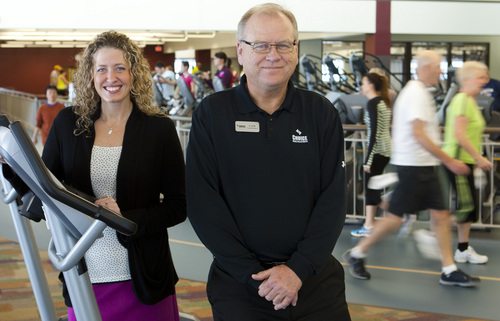By Ryan Bakken
Grand Forks Herald
Cam Tweten was a fitness club manager and Brandy Chaffee was a public relations director for the Grand Forks Park District, neither with fundraising experience, when they were appointed to head the Imagine campaign to solicit the money for what became Choice Health & Fitness.
Along with an ever-growing list of allies, they raised $27 million — $3 million going for Y Family Center improvements and $24 million for the construction of the multifaceted and voluminous Choice on the city’s south end.
The money was broken down by $17 million in donations and $10 million in leases.
With more amateurs than professionals, especially in the early stages of the seven-year effort, Chaffee said campaign members adopted an anthropologist Margaret Mead quote that summarized the group’s efforts.
Mead’s quote was: “Never doubt that a small group of thoughtful, committed citizens can change the world; indeed, it’s the only thing that ever has.”
Those volunteer citizens eventually received fundraising help along the way from other sources, absorbing advice from professionals such as Kristi Mishler, executive director of the local community foundation; private consultant Jim Holdman of Grand Forks; and grassroots workers such as Rohinee Damle, who already had made a fundraising name for herself before joining the effort.
Tweten said it helped that the askers were local, even if they weren’t experts.
“When we talked to people, we already had a trust level to tell our story because we’re from here,” Tweten said. “That’s compared to an outside fundraiser who didn’t have those relationships.”
Following is fundraising advice from people involved with Choice and other fundraising efforts.
Keep beginning quiet
Holdman and son Scott operate Funding Logic, a national consulting firm that has worked with more than 300 nonprofits.
Through the Dakota Medical Foundation of Fargo, the Holdmans were enlisted to advise the Forks Area Health & Wellness Committee that led the Imagine campaign.
“The first thing a group has to do is get their message straight,” Jim Holdman said.
Another early need, he said, is to do the soliciting quietly.
A common mistake in fundraising is that the group wants to tout its early successes, with the idea the publicity will prompt other givers. It doesn’t work that way, Holdman said.
“Don’t let the news media know anything until you know you are going to succeed,” he said. “People think newspaper articles help you get publicity. But you want to know you’re going to be successful before you go public.”
Since the project was aired publicly because a government entity was involved, the behind-the-scenes strategy was impossible. But Holdman said the sales pitches needed to be tailored to potential donors’ value systems, not the facility.
“You keep the emphasis on principles, such as (helping) children who are obese and women who have heart trouble,” Holdman said. “You keep the emphasis off building another fitness center.
“It’s not about the organization’s need to have something but rather the donors’ need to give something.”
It’s also important, he said, to know the donors. “Don’t ask anyone for money until you know their dog’s name,” Holdman said.
Believing in the cause
Dave Sena, director of the Northlands Rescue Mission in Grand Forks, said he has followed Holdman’s advice. Since Sena’s start in 2001, annual donations to the mission have gone from $400,000 to $1.2 million and annual volunteers have gone from 50 to 1,000. Seventy percent of the mission’s income comes from donations.
“It’s all about how much donors and volunteers match our value system,” Sena said. “If they believe in what we do, they’ll give.
“They also want to know that you’re real and care more about them than their donations.”
Spreading the word
Damle, the wife of an Altru physician who retired in December, is known for starting the Harvest Gala, which has raised more than $1 million for the Altru Health Foundation under her nine years of leadership.
She joined the Imagine team with similar gusto, as she hosted dozens of teas and suppers at their home to spread word of the project. Altru eventually became a partner at Choice.
“My interest in Choice started because of tennis,” said Damle, who now lives in Las Vegas. “As I got more involved, I learned of the obesity and diabetes issues. As a doctor’s wife, that interested me.”
Damle said enthusiasm rubs off on others.
“If you want people to say ‘yes,’ the most important thing is that you feel passionate about what you’re doing as a fundraiser,” she said. “That way, other people will get excited about it. We worked with passion and heart because we loved the project.”
A record catch
Within 24 hours of graduation, UND alumni receive a congratulatory email from Tim O’Keefe, CEO of the UND Alumni Association and Foundation.
“At that point, it’s nothing more than establishing a contact,” O’Keefe said.
As attested by last fall’s announcement of the record-setting $324 million in donations being raised by his organization’s North Dakota Spirit Campaign, O’Keefe’s organization obviously doesn’t stop there in touching base with alumni.
When it comes to seeking a major gift, O’Keefe said the foundation first makes at least seven “touches” with a potential donor, the majority of them coming face-to-face.
Then it’s a four-step process:
–Establish a personal relationship. “The main way to do that is by listening,” O’Keefe said. “You need to find out what’s most important to them.”
–Offer giving “opportunities.”
–Make “The Ask,” fundraising’s slang for requests. “A passive approach is not the right approach at that stage,” O’Keefe said.
–Once The Ask has been made, “you shut up until the individual responds,” O’Keefe said.
















































































































































































































































































































































































